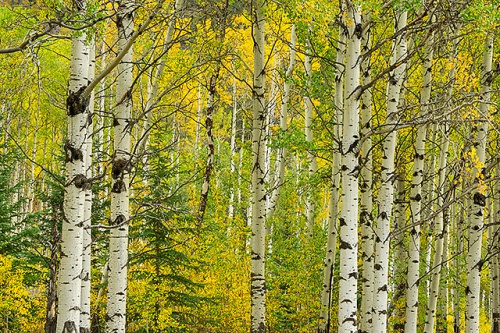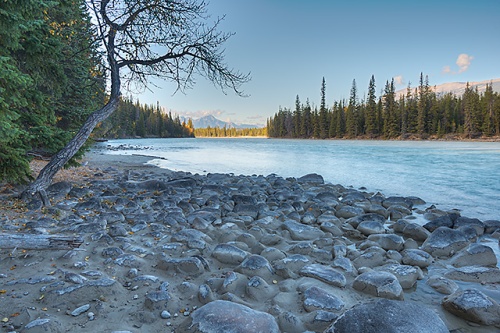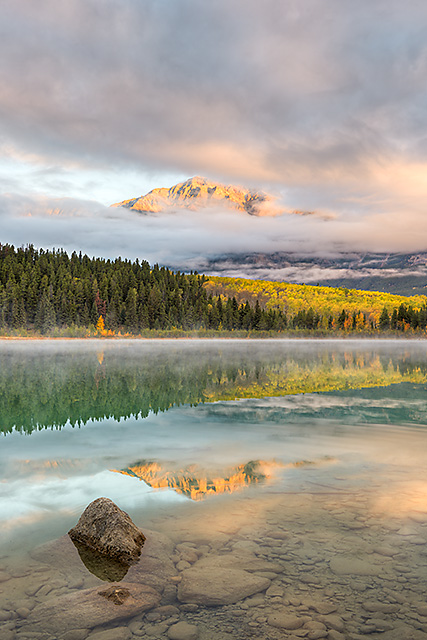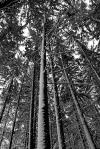I’d wanted to visit the Canadian Rockies for quite some time, but for some reason it never seemed feasible. I’ve been taking photo trips, with regularity, since 2002, but–until this past fall–I’d only flown as part of the travel to my photo destination four times. And I’d never crossed an international border to do it. But for a variety of reasons (the details of which I won’t bore you with) it seemed different in May of last year when I was pondering what to do for the autumn. One thing led to another and I went through the crank turning process of making plans to spend two weeks in the Canadian Rockies during what I hoped would be the fall color season.
If you’ve been following this series, which I began to post back in October, you know things turned out pretty well. My timing was good as far as color was concerned; I received good weather (mostly–we won’t talk about Lake O’Hara); I had excellent sources upon which to draw and covered a lot of ground without feeling too rushed.
Mostly, I had the opportunity to experience what quietsolopursuits, a regular reader of and commenter upon this blog, has referred to several times as “one of the most beautiful places on earth.” (I must add that, while I haven’t had the opportunity to see all that many spots on the planet, it’s hard for me to imagine that this characterization is wrong, because it’s difficult to fathom that there are many, if any, more beautiful areas than the Canadian Rockies.)
Prior to this trip, I had spent almost no time photographing in an alpine environment. I really didn’t know what I’d been missing, though I suppose I had an inkling. It didn’t take long before I was deeply immersed in the unique aesthetic facets of this mountainous setting. And there are some pretty significant differences photographing in comparatively tall mountain chains like the Rockies and much older, shorter ones such as the Appalachians. The Great Smoky Mountains in Tennessee and North Carolina are part of the southern Appalachians and I’ve photographed there–and further north in West Virginia–numerous times, but the comparative experience with the Rockies is distinct, and in some less than subtle ways–ways that are informed by specific photographic choices.
I purchased the Nikkor 14-24 ultrawide angle lens when I moved to “full frame” capture at the tail end of 2008, so it’s been in my gear bag for more than six years now. I can say, with little fear of contradiction, that I used the 14-24 more frequently during my two weeks in the Canadian Rockies than I had in the previous five years and nine months combined. There’s something about the setting that fairly begs for sweeping, wide angle expression. That may make sense when comparing shooting opportunities in the Canadian Rockies to my normal haunts in the American Midwest–where broad vistas are few and far between. But I found the urge to go very wide much stronger in the Rockies than I did in other fairly “wide open” locales, such as southern Utah, Nevada and Arizona. I used the 14-24 in all of these places, but not nearly as often as I did in Canada.
The fearful consequence of going very, very wide when shooting is including too much in the scene–something I’m always well-aware of–but to my eye, that was seldom a problem when I looked through the viewfinder with the 14-24 mounted on the camera while in the Rockies. Unlike anywhere else I’ve ever shot, 24mm simply wasn’t wide enough in a large number of places.
And yet, despite the pull of the ultrawide angle, I found that I was still able to see the landscape in a more detailed, intimate manner as well. It’s a view I’ve become accustomed to over the years–a function of my copious experience shooting landscapes in tight, cluttered settings, I’ve opined.
Part of the reason I found this trip to be so memorable–and, quite literally, not a day has gone by in the nearly 4 1/2 months since I returned when I haven’t reflected at some length on the experience–is that, through my photographic choices in the field, I was able to let the palpable grandeur of the landscape speak for itself without compromising my ability to portray it through my own eyes. At least I think I was able to do that. (I certainly hope so, in any event.)
This is part of the reason why every shooting day was so full; I was steadily occupied with the attempt to reflect a kind of organic feel that I was developing for the place. At the risk of getting all ephemeral, it was as if I spent time at each location working to let the Rockies be the Rockies, and reflecting that sentiment through the lens. Then, when I was satisfied that I’d at least begun to accomplish that task, I’d let my eyes do the kind of seeing that they’ve sort of been trained to do in settings where there was no real alternative.
Whatever fuzzy line that might divide these two approaches disappeared in the many meadows that I visited on the trip, something I discussed at length in a “meta” post a few weeks ago. It was in these marvelous places that all of the elements of wonder seemed to come together so effortlessly.
Above all, there was the peace and quiet. With few exceptions (the area around the Lake Louise Chateau, for instance), things were peaceful and relatively empty. On one of the days that I was at Jasper, I took a hike from the Beaver Creek Picnic Area, past Beaver Lake to the First and Second Summit Lakes. It was an almost entirely clear afternoon, with temperatures in the 60s (F). The trail was nearly flat and, though it climbed over a number of rock slide areas, was easy going. The round trip was about eight miles all told, and though it was mostly a bust in terms of photography (despite some decent shots at Beaver Lake on the return trip; the two Summit Lakes had extremely low water levels, the light was poor and the aspen stands around both lakes were fairly picked over) it was still a delightful experience. After I passed Beaver Lake, I never saw another soul and, outside of the occasional bird call and the sounds associated with a light breeze and the tread of my own feet, all I experienced was quietude. This was the rule rather than the exception.
What do you do after visiting the Canadian Rockies? Two things.
1) You spend time, daily, remembering, seeing through your mind’s eye what those two weeks were like.
2) You count the days until you can return–something I hope to do in September of this year. (I have a great deal of unfinished business at Lake O’Hara.)
If that comes to fruition, and I’m increasingly hopeful that it will, I’ll document the wonders of that experience here and I hope you’ll come along for the ride.
Thanks for reading about my time in the Canadian Rockies. In my next post, I’ll return to more topical subject matter.


















It’s really a beautiful place
By: SAN_jeet on February 16, 2015
at 9:09 am
Thank you!
By: kerryl29 on February 16, 2015
at 8:17 pm
Very beautiful pictures
By: SAN_jeet on February 16, 2015
at 9:09 am
Thanks very much!
By: kerryl29 on February 16, 2015
at 8:18 pm
Beautiful pictures! Fall is definitely one of the best times to visit 🙂
By: robrockies on February 16, 2015
at 9:18 am
Thanks, and agreed–the Rockies were terrific in the fall.
By: kerryl29 on February 16, 2015
at 8:19 pm
All so very beautiful! Wish they were mine. I especially love Sunrise, Waterfowl Lakes. Those clouds are wonderful.
By: denisebushphoto on February 16, 2015
at 9:27 am
Thanks, Denise. Yes, we were treated to an outstanding sunrise at Waterfowl Lakes that morning.
By: kerryl29 on February 16, 2015
at 8:24 pm
We’re off to Sedona and environs in early March for a week or so. Any lens recommendations for monument valley, petrified forest, Grand Canyon,Painted Desert, Cathedral Rock, etc. Any specific lens suggestions? I’m torn between fast fixed wide angle and slower wide zooms. I shoot with both Canon DSLR and film bodies.
By: agarrabrant on February 16, 2015
at 10:24 am
Honestly, I’d bring whatever you can carry. I routinely take a series of zoom lenses that range from 14 to 400 mm and when I was in Arizona for a week back in 2013 I used every lens in my bag. Of course, it depends on your shooting proclivities but if you take a look at a wide assortment of the images in my posts on this blog you’ll see that I cover a wide assortment of focal lengths on a regular basis.
Having said that, if you’re limited in terms of what you can bring with you, I’d make certain to have the wide angle covered. I can’t imagine not wanting to shoot grand scenics in the locations that you mentioned.
I shot with a series of prime lenses for years, but moved to zooms (excluding a fixed focal length macro lens) about 15 years ago, and now that’s all I own (excepting the macro lens).
By: kerryl29 on February 16, 2015
at 8:32 pm
About what I had figured. I’ve got the mid ranges covered say 35mm- 300mm. I think I’ll plan to rent a 14-35mm f3.5-4.5, a 100- 400mm f4.5-5.6. I think I’ll also rent a 24mm f2.4 pancake lens for grins.
By: agarrabrant on February 17, 2015
at 12:13 am
If you’re covered up to 300 mm you may not feel the need to rent the 100-400; a lot of landscape photographers feel that covering up to 200 mm is plenty. I’m a bid of an oddball in that respect in that I like to push well past that mark not infrequently, particularly when I’m shooting from overlooks.
On the wide end…yeah, I think you’ll definitely want to go A LOT wider than 35mm (in 35 mm format terms–I’m not sure whether you’re shooting with a cropped sensor camera or not).
FWIW, re fast primes, unless you’re planning to do some night photography (star trails, for instance), they’re probably unnecessary for the locations you mentioned…and if you DO want to do so, I’d go as fast as possible–f/1.8, f/1.4…something in that range.
By: kerryl29 on February 17, 2015
at 9:16 am
My current DSLR body is an ancient (in digital terms) Rebel XSi and it does use an aps format CMOS sensor. So that gives me a X1.6 on my effective full 35mm sensor length right? That makes a 35mm lens more like a 40mm I guess. I have been debating a new body but I don’t know what to get. Until very recently, a new camera body was a non-starter. Now I can look but I have been deliberately not looking for so long, I really have no idea what the state of the art is. The XSi is 14megapixles or so. A good friend has a T4i which is 18mpx or so but even that is two generations old now. I will not be dropping 5 grand on this hobby but something in 1 grand up to maybe 2 is imaginable. I’ll probably stick with Canon since I already have a fist full of lenses beyond the kit lenses. Thanks for the time and Ideas. I’m really looking forward to a new environment to shoot.
By: agarrabrant on February 17, 2015
at 12:30 pm
Yes, the Canon APS-C format is a 1.6 multiplier to determine 35mm equivalent focal lengths. (Nikon, Sony, Pentax, etc. APS-C sensors are 1.5.) So, your 35mm lens is actually framing like a 56mm lens on a full frame camera–that’s slightly more than “normal” (normal, or roughly equivalent to human vision is 50 mm in 35mm film terms). To achieve anything in the ultrawide field of view area with your camera, you’ll need something in the 10-12 mm focal length.
There’s far more to newer generation sensors and behind the scenes in-camera processing than simply an increase in pixels. The gains in dynamic range, general noise reduction, and high ISO performance are probably more significant (at least in my opinion).
If you’re willing to spend up to $2K, you have a lot of options available to you in the Canon line–both APS-C and full frame and if you’re willing to consider the used market you have even more viable choices. (I’m not a Canon shooter myself but I have many friends and acquaintances who are and I have a passing familiarity with the Canon lineup above the Rebel class, both APS-C and full frame).
Of course, you don’t HAVE to upgrade at all. If you’re happy with the results you’re getting with your present body, why bother?
By: kerryl29 on February 17, 2015
at 1:23 pm
I like my XSi but at the risk of sounding egotistical, I’ve about outgrown it. I need denser resolution, broader range, and I really want a larger sensor.
By: agarrabrant on February 17, 2015
at 8:03 pm
If you want to move up to full frame and you want to stick with Canon, given your budget, the only option for buying new is the 6d:
http://www.bhphotovideo.com/c/search?Ntt=canon+eos+6d&N=0&InitialSearch=yes&sts=ps
Looks like there’s a substantial mail-in rebate on the camera ($300) that expires at the end of this month. (Makes me wonder if an upgrade to this, Canon’s consumer level full frame, is on the way in the near future.)
If you’re comfortable dipping into the used market, you probably have other options. Canon very recently announced the forthcoming 5Ds/r twin models. This should produce a substantial inflow of 5d mark iii cameras onto the used market over the next few months. The camera is selling new for $3100, less a $300 rebate, at the moment. I would assume the Canon has ceased production of this camera (or will imminently). If my experience with Nikon’s D8xx series is any predictor, used 5diii bodies that are in good shape with modest shutter actuations should be available for less than $2000, if they aren’t already. The 5Diii is a significantly more robust (in terms of build, features and performance) than the 6d.
http://www.bhphotovideo.com/c/search?N=10847545&InitialSearch=yes&sts=pi
Food for thought.
By: kerryl29 on February 17, 2015
at 9:10 pm
A great overview and interesting how a place can haunt you making you yearn to go back.There is a short hike outside Field to a falls that I had to turn back from because it was getting dark and I was alone in bear country.I love all your images but kept stopping to ponder the reeds. Book now for O’Hara.
By: My Heartsong on February 16, 2015
at 10:29 am
Thanks, Jane.
It’s too early to book Lake O’Hara; the call has to be made three months to the day before you want to visit the area.
By: kerryl29 on February 16, 2015
at 8:34 pm
Thanks for this. I should do this myself.
By: My Heartsong on February 18, 2015
at 6:01 am
Hey Kerry… big thanks for the retro post. This seemed to bring it all together for me after following your adventure. As an early follower of your blog this last post reflected a change in (voice) for your writing. I find it most pleasing the ebb and flow… almost as if you were walking the reader through your feelings. My second observation was the way your pictures have evolved… not sure if it is your eye for comp or your post process… but what ever it is, as a viewer and photographer I find it extremely inviting. As a reader the pics matched the mood (quietude… love that) of the place and your place in it. Thank you for keeping me inspired and educated at the same time.
By: MikeP on February 16, 2015
at 10:38 am
Thanks very much, Mike. I really appreciate the kind, thoughtful words.
By: kerryl29 on February 16, 2015
at 8:36 pm
I totally agree that the Canadian Rockies provide exceptional beauty and great diversity that pull at the mind and make you want to return over and over again. While you plotted a wonderful trip that hit so many visual and emotional high points as displayed and described in your posts, there is a lot that remains unexplored. It awaits you…
By: EllenK on February 16, 2015
at 11:06 am
Thanks very much, Ellen. You’re absolutely right–I feel as though I did little more than scratch the surface in the Canadian Rockies.
By: kerryl29 on February 16, 2015
at 8:38 pm
Great series Kerry: I’ve kept some of the images in my saved area. Keep it up!
By: elmdriveimages on February 16, 2015
at 4:32 pm
Thanks!
By: kerryl29 on February 16, 2015
at 8:38 pm
Reblogged this on seanaldenfitzgerald and commented:
Cannot get over these pics.
By: seanaldenfitzgerald on February 16, 2015
at 5:00 pm
Thank you!
By: kerryl29 on February 16, 2015
at 8:39 pm
You’re most welcome 🙂
By: Sean Alden Fitzgerald on February 17, 2015
at 10:42 am
A great summary of your travels / photo posts from the Rockies. Hope you get the change to revisit Lake O’Hara! We cross country skied to the lodge a couple of weekends ago, beautiful in the winter as well!
By: Girl Gone Expat on February 16, 2015
at 10:15 pm
Thanks very much.
Did you ski to the lodge from the O’Hara parking area? If so, I’m greatly impressed…that’s a long haul, and uphill all the way there.
By: kerryl29 on February 17, 2015
at 9:19 am
Yes we did, it was a bit more uphill then I had expected, but we had the whole day so didn’t rush it. The lodge offered lunch so had a nice break before returning to the car. It was on the way down I really noticed how steep some of the hills were! 🙂
By: Girl Gone Expat on February 17, 2015
at 9:31 am
I am indeed impressed. I had considered hiking up to Lake O’Hara with full gear if for some reason I couldn’t secure a reservation on the bus, but that would be a long, unpleasant one-way hike with a 35-pound pack. And I didn’t realize that the Lake O’Hara lodge was open in the winter. You learn something new every day. 🙂
By: kerryl29 on February 17, 2015
at 1:31 pm
Great Photos of the Rockies well done
By: humphries346 on February 17, 2015
at 11:08 am
Thanks!
By: kerryl29 on February 17, 2015
at 1:27 pm
Inspiring. I’d love to go there. There is so much to see in this world!
By: emmager on February 17, 2015
at 1:21 pm
Thanks very much.
If you ever do have the opportunity to visit the Canadian Rockies, I encourage you to do so. They’re home to a phenomenally beautiful landscape.
By: kerryl29 on February 17, 2015
at 1:26 pm
First of all, thank you for the shout out.
I do hope that your planned return visit works out for you, as I have thoroughly enjoyed every image and word contained in these posts! They’ve brought back so many memories to me, along with seeing the work of a true master of his craft, and hopefully, learning a little at the same time.
By: quietsolopursuits on February 17, 2015
at 2:35 pm
Thanks very much for the kind remarks. Obviously, I hope I can return to the region as well. 🙂
By: kerryl29 on February 17, 2015
at 9:00 pm
Reblogged this on neonr4.in and commented:
Beautiful shot from Lightscapes Nature Photography Blog at Canadian Rockies here
By: neonr4in on February 19, 2015
at 4:53 pm
Love your photos…amazing! Makes me want to go back and explore Banff more! Well done!!
By: mollyvenrick on February 22, 2015
at 4:09 pm
Thanks very much!
By: kerryl29 on February 22, 2015
at 4:30 pm
Reblogged this on Veli Korpikannas and commented:
Like Finland…..
By: Veli Korpikannas on April 9, 2015
at 11:37 am
Never having been to Finland, I’ll take your word for it. 🙂
By: kerryl29 on April 9, 2015
at 11:50 am
: )
By: Veli Korpikannas on April 9, 2015
at 12:11 pm
[…] Last fall, I spent a couple of weeks photographing in the Canadian Rockies. It was a tremendous experience and I came home with a bushelful of great memories and some images that I was happy with as well. As great as the trip was, it ended with a focus on a couple of disappointments–most particularly a day of miserable weather at the elusive Lake O’Hara. As a result, I came home with a burning desire to return to the region as soon as possible. Without going through the specifics, I managed to figure out a way to go back to the Canadian Rockies this fall. I flew from Chicago to Calgary on September 15 and returned to the American Midwest on September 30. […]
By: The Canadian Rockies Revisited | Lightscapes Nature Photography Blog on October 5, 2015
at 9:55 am
[…] most consequential of these examples was at Lake O’Hara. On my first visit to the Canadian Rockies, I managed to snag a single day pass to Lake O’Hara at something close to the last minute. […]
By: Second Chances | Lightscapes Nature Photography Blog on February 11, 2019
at 8:41 am
[…] image discussed in this post was made during the photo tour that was part of my first trip to the Canadian Rockies, in the autumn of 2014. This was around the midpoint of the tour and Day 11 of the entire trip […]
By: The Story Behind the Image: Waterfowl Lakes Sunrise Perfection | Lightscapes Nature Photography Blog on April 13, 2020
at 9:07 am
[…] something I’ve fallen into the trap of doing myself. Case in point: before I made my first trip to the Canadian Rockies in 2014 I purchased copies of Darwin Wiggett’s ebook photo guides to the Canadian Rockies […]
By: Thematic Interruption: The Search for Photographic Opportunities | Lightscapes Nature Photography Blog on November 23, 2020
at 9:00 am